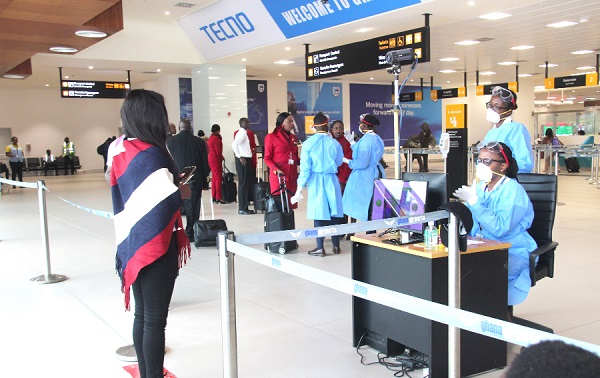
Minister inspects coronavirus equipment at Kotoka Airport
The Minister of Health, Mr Kwaku Agyeman-Manu, has conducted some journalists round the Kotoka International Airport for them to see at firsthand, systems put in place to prevent the spread of the coronavirus in the country.
The involvement of the media was also aimed at raising public awareness about the global health threat as part of preventive measures.
Advertisement
During the exercise, the Daily Graphic observed that staff of the Port Health Department were in full personal protective equipment (PPE) from head to toe, including surgical nose masks, gloves, goggles and water resistant medial overalls.
The screening with thermal temperature scanners is to enable the health workers to isolate people with high temperatures or fever, which is an initial symptom of the coronavirus.
The team observed that due to the infectious nature of the disease, temperature screening at the airport was being conducted with non-contact thermometer guns and thermal thermometers.
The leader of the monitoring team and National Coordinator for Port Health, Dr Dennis Laryea, explained that anybody with a temperature of above 37.5 degree celsius was taken to the holding room for further investigation, which, he said, started with double-checking and confirming the high temperatures of individuals with the non-contact thermometer guns.
He said if deemed necessary, such a person would be transported in an ambulance to any of the national designated centres for coronavirus treatment and management.
Thermal thermometers
Dr Laryea said the thermal thermometers used sensors to detect abnormal temperatures and sounded an alarm, with a green light signalling a pass, and a red indicating the person had to be isolated.
The person being screened is made to step on a red-coloured designated point created at a few metres from the port health official who monitors from a computer screen.
Dr Laryea said in cases of manifest symptoms, an ambulance would convey the person to a designated treatment and management centre.
Additionally, entrants were made to sanitise their hands with sanitisers provided at the airport before heading to immigration checkpoints.
Other public awareness measures observed included electronic display of detailed information on the disease, particularly preventive measures, on screens mounted on conveyor belts at the luggage reclaim areas.
Media briefing
Briefing the media after the tour, Mr Agyeman-Manu called on the public not to panic but have confidence in the national surveillance system.
He also called on families with relations in China to rest assured that their relations were safe and that the government had the situation under control in collaboration with the Chinese government.
He said if an evacuation became necessary, the government was ready to do that.
Prevention
Mr Agyeman-Manu said the disease had no cure but could only be managed and, therefore, prevention was very critical.
He said as an air borne disease, it was critical for the public to imbibe basic hygienic practices such as not spitting indiscriminately; covering the mouth before coughing or sneezing as well as regular washing of hands with soap under running water.
Writer's email [email protected]



